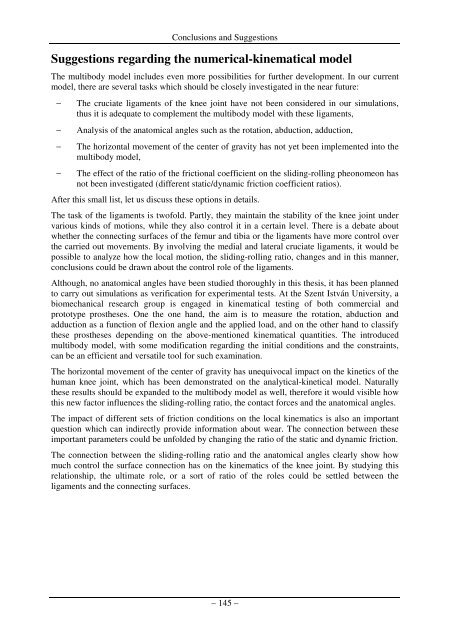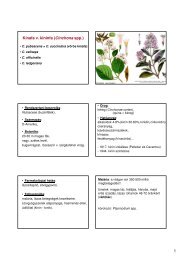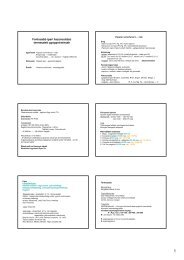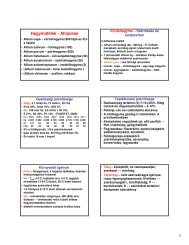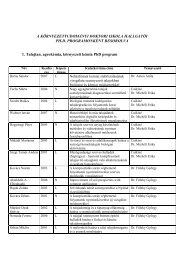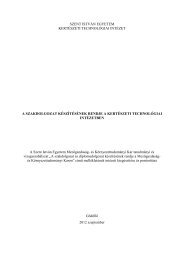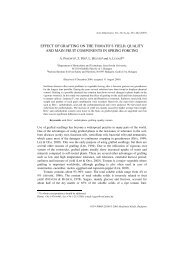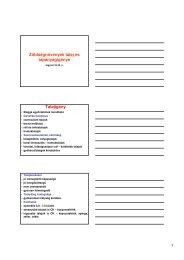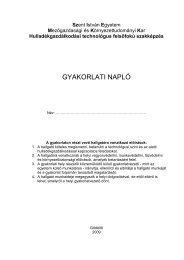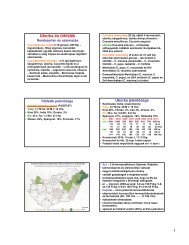PhD Fekete - SZIE version - 2.2 - Szent István Egyetem
PhD Fekete - SZIE version - 2.2 - Szent István Egyetem
PhD Fekete - SZIE version - 2.2 - Szent István Egyetem
You also want an ePaper? Increase the reach of your titles
YUMPU automatically turns print PDFs into web optimized ePapers that Google loves.
Conclusions and Suggestions<br />
Suggestions regarding the numerical-kinematical model<br />
The multibody model includes even more possibilities for further development. In our current<br />
model, there are several tasks which should be closely investigated in the near future:<br />
−<br />
−<br />
−<br />
−<br />
The cruciate ligaments of the knee joint have not been considered in our simulations,<br />
thus it is adequate to complement the multibody model with these ligaments,<br />
Analysis of the anatomical angles such as the rotation, abduction, adduction,<br />
The horizontal movement of the center of gravity has not yet been implemented into the<br />
multibody model,<br />
The effect of the ratio of the frictional coefficient on the sliding-rolling pheonomeon has<br />
not been investigated (different static/dynamic friction coefficient ratios).<br />
After this small list, let us discuss these options in details.<br />
The task of the ligaments is twofold. Partly, they maintain the stability of the knee joint under<br />
various kinds of motions, while they also control it in a certain level. There is a debate about<br />
whether the connecting surfaces of the femur and tibia or the ligaments have more control over<br />
the carried out movements. By involving the medial and lateral cruciate ligaments, it would be<br />
possible to analyze how the local motion, the sliding-rolling ratio, changes and in this manner,<br />
conclusions could be drawn about the control role of the ligaments.<br />
Although, no anatomical angles have been studied thoroughly in this thesis, it has been planned<br />
to carry out simulations as verification for experimental tests. At the <strong>Szent</strong> <strong>István</strong> University, a<br />
biomechanical research group is engaged in kinematical testing of both commercial and<br />
prototype prostheses. One the one hand, the aim is to measure the rotation, abduction and<br />
adduction as a function of flexion angle and the applied load, and on the other hand to classify<br />
these prostheses depending on the above-mentioned kinematical quantities. The introduced<br />
multibody model, with some modification regarding the initial conditions and the constraints,<br />
can be an efficient and versatile tool for such examination.<br />
The horizontal movement of the center of gravity has unequivocal impact on the kinetics of the<br />
human knee joint, which has been demonstrated on the analytical-kinetical model. Naturally<br />
these results should be expanded to the multibody model as well, therefore it would visible how<br />
this new factor influences the sliding-rolling ratio, the contact forces and the anatomical angles.<br />
The impact of different sets of friction conditions on the local kinematics is also an important<br />
question which can indirectly provide information about wear. The connection between these<br />
important parameters could be unfolded by changing the ratio of the static and dynamic friction.<br />
The connection between the sliding-rolling ratio and the anatomical angles clearly show how<br />
much control the surface connection has on the kinematics of the knee joint. By studying this<br />
relationship, the ultimate role, or a sort of ratio of the roles could be settled between the<br />
ligaments and the connecting surfaces.<br />
– 145 –


